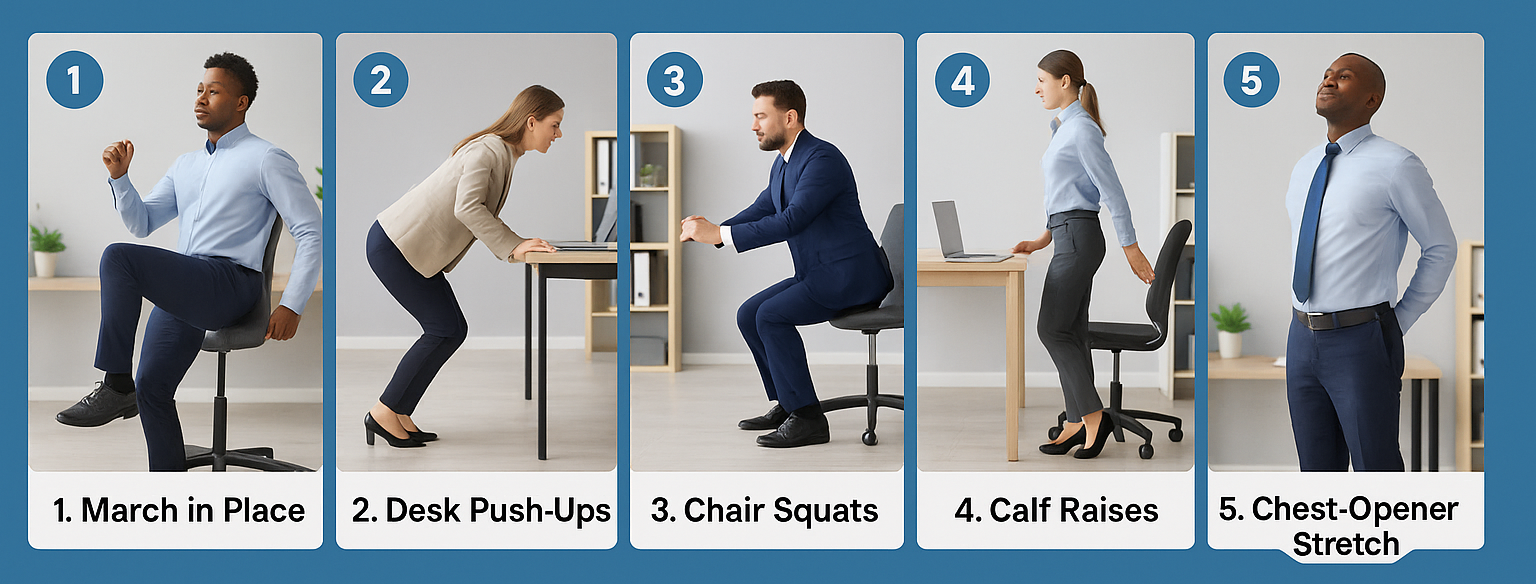“People who remain seated 10 or more hours a day have a 147 % higher risk of heart attack or stroke than their more active peers.”
~ (Biswas et al., 2015)
Picture a typical weekday: You roll out of bed, shuffle to the kitchen for coffee, plop down to scroll the headlines, drive (or ride) to work, and spend the next eight to ten hours glued to a chair that was designed more for stacking than for human health.
After the commute home comes dinner, a little Netflix, maybe some late-night email triage…and before you know it, you’ve logged well over 10 hours of sit-time.
People who camp out in a chair that long increase their risk of a heart attack or stroke by a jaw-dropping 147 percent, even if they faithfully hit the gym before work.
If your first instinct is to quit your job, buy a Peloton, and train for a half-marathon, take a breath. Modern life is built around desks and screens; the solution isn’t to torch your swivel chair.
Instead, a growing stack of research says the damage can be dramatically blunted with tiny, two-minute “movement snacks” scattered through the day. Science geeks call them sedentary breaks. We’re going to call them micro-moves because that sounds more fun, and fun means you’ll actually do them…or so I think.
But before we go into the micro-moves, let’s answer a very important question:
How is Sitting Quietly a Heart Hazard?
Think of your leg muscles as little fuel pumps. When they lie dormant, blood starts to pool in your calves, forcing your heart to push harder just to keep circulation going. Over hours, this can lead to higher blood pressure in that the heart is working extra to push blood through your vessels.
Little wonder that uninterrupted sitting has been linked to hypertension and poor circulation (Diaz et al., 2017).
Over time, that sluggish flow triggers:
- Rising blood pressure. Even marathoners see a creep in systolic numbers if the other 23 hours are statue-mode.
- Spiking triglycerides and blood sugar. Muscles burn less fat and get stingy with insulin, so cholesterol and glucose wander upward.
- Grumpy arteries. Sitting all day means low blood flow shear stress, which can lead to endothelial dysfunction (an early warning sign for hardened arteries) (Padilla et al., 2018.
Add it all up and you’ve got a perfect recipe for hypertension, metabolic syndrome, and premature heart disease. The risk is hard to ignore in the U.S., where a typical worker racks up 6.5 hours of weekday sitting (and many admit to far more).
The good news? Every short movement break turns that tide the other way, so let’s get right into them.
If you’re able, a standing desk is another great option. Just being on your feet encourages subtle shifts, hip rotations, and better leg circulation.
Personally, I make it a point to step away from my desk every hour and spend a few minutes moving. After all, movement really is medicine.
Micro-moves: your two-minute circulation reset
Researchers at the University of Queensland asked desk jockeys to stand up and wiggle for one to two minutes every half hour. Within three months, their average blood pressure drifted downward, and their energy shot up.
In other words, you don’t need another hour-long workout; you need thirty seconds here, a minute there, sprinkled like seasoning across your day.
Below are five easy micro-moves you can do between Zoom calls or whenever you need a pick-me-up. Each one takes only ~2 minutes, requires no equipment, and will help undo the harm of sitting, keeping your heart, blood vessels, and blood pressure happier.
Micro-Move 1: “March” in Place
Remember jogging in place during elementary school gym? Same idea, zero playground drama.
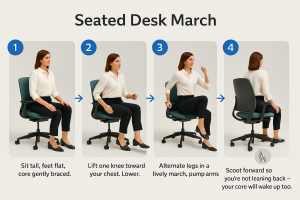
How to do it
- Sit tall, feet flat, core gently braced.
- Lift one knee toward your chest. Lower.
- Alternate legs in a lively “march,” pumping your arms for extra oomph.
- Keep it up for 30–60 seconds; repeat once so you hit roughly two minutes.
Pro tips
- Scoot forward so you’re not leaning on the backrest. Your core will wake up too.
- Add ankle weights if you work in a very trusting office environment.
Heart-smart benefits:
This simple move acts like a circulatory wake-up call. As you march, your calf and thigh muscles contract and relax, which helps push blood back up to your heart, counteracting the pooling in your legs from sitting.
It’s great for promoting healthy blood flow and can even give a slight boost to your heart rate. Over time, regular little cardio bursts like this can improve your overall cardiovascular fitness and help lower blood pressure (Carter et al., 2015). Plus, you’ll likely feel more alert, as it’s an instant energy booster during that mid-afternoon slump!
Micro-Move 2: Desk Push-Ups
Think regular push-ups, but your desk is the floor, and your nice shirt stays clean.

How to do it
- Stand an arm’s length from a sturdy desk. Palms on the edge, shoulder-width, arms straight.
- Walk your feet back until your body forms a plank.
- Bend your elbows, inhaling as your chest drifts toward the desk.
- Exhale, press back to start.
- Nail 10–15 reps; total time ≈ 90 seconds.
Pro tips
- The farther your feet, the tougher the push-up—slide back as you get stronger.
- Sneak in a set mid-morning and another after lunch.
Heart-smart benefits:
Desk push-ups are a fantastic way to get your heart rate up for a minute while also strengthening your upper-body muscles.
You’re using large muscle groups (chest, arms, shoulders), which means your heart has to pump more blood to fuel them, giving you a quick cardiovascular boost.
This helps counteract that slow, sluggish circulation from sitting. Over time, building a bit of muscle can improve your resting metabolism and insulin sensitivity, which supports heart health and better blood sugar control (Dempsey et al., 2016.
Micro-Move 3: Chair Squats
Stand-sit-stand-sit until your quads send thank-you notes.
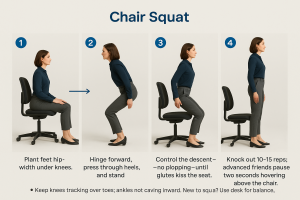
How to do it
- Plant feet hip-width under (or just behind) knees.
- Hinge forward slightly, press through heels, and stand.
- Control the descent—no plopping—until your glutes kiss the seat.
- Knock out 10–15 reps; advanced friends pause two seconds hovering above the chair.
Pro tips
- Keep your knees tracking over toes; ankles not caving inward.
- New to squats? Use the desk for balance until confidence builds.
Heart-smart benefits:
Chair squats are a powerhouse because they engage the largest muscles in your body – your legs and glutes. This not only helps reverse the muscle weakening from sitting but also gives a brisk boost to your circulation and heart rate (Ekelund et al., 2016).
When big muscles like your thighs contract, they squeeze blood vessels and send blood back to the heart more efficiently, acting like a “second heart” for circulation.
You might even feel slightly winded after 15 squats, which means you’ve given your cardiovascular system a mini workout. Over time, daily squats can improve your leg strength and endurance, making activities (and further exercise) easier. All these are great for your heart.
Strong legs also aid better blood sugar control because muscles use glucose for fuel; in fact, regular muscle-engaging moves can improve insulin sensitivity.
Lastly, by standing up frequently, you’re combating that extended chair time linked to higher heart disease risk. You’ll also notice less stiffness in your hips and back – an added bonus.
Micro-Move 4: Calf Raises
Rise onto tip-toes, drop, repeat—ballerina grace optional

How to do it
- Stand behind your chair, fingertips light on the backrest.
- Lift heels slowly, pause a beat at the top.
- Lower under control.
- Hit 15–20 reps; do a second set if the conference call drags on.
Pro tips
- On a plane? Do the seated version to battle ankle puffiness.
- Try single-leg raises for a balance challenge.
Heart-smart benefits:
This micro-move is all about improving circulation in your lower extremities. When you perform calf raises, the contraction of your calf muscles acts like a pump pushing blood from your legs back up toward your heart.
This is crucial after you’ve been sitting and blood has pooled in the feet and ankles. By doing a minute or two of calf raises, you’ll help re-engage that venous return and reduce any swelling or stagnation in the lower legs.
In fact, doctors often recommend ankle/calf pump exercises on long flights to prevent blood clots and keep blood moving in the legs. Regularly activating your calves can also gently lower blood pressure over time by improving overall vascular function.
Micro-Move 5: Chest-Opener Stretch
Superman pose meets yoga chill.
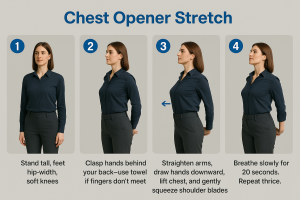
How to do it
- Stand tall, feet hip-width, soft knees.
- Clasp hands behind your back—use a towel if fingers don’t meet.
- Straighten arms, draw hands downward, lift chest, and gently squeeze shoulder blades together.
- Breathe slowly for 20 seconds. Repeat thrice.
Pro tips
- Keep chin level; eyes on the horizon—not craning skyward.
- Vary arm angle for a new stretch each round.
Heart-smart benefits:
This stretch directly combats the “desk hunch” by opening up tight chest muscles, it helps improve your posture and allows blood to circulate more freely in your upper body.
A tight chest can impair breathing; by doing this opener, you take fuller breaths which boost oxygen intake and can slow your heart rate, activating a relaxation response that may lower your blood pressure temporarily.
Reducing tension in your shoulders and chest also eases the workload on your neck and back muscles, potentially decreasing stress-related aches. Psychologically, standing tall with an open chest can even make you feel more energetic and positive – fighting off that drained, tense feeling we often get after long meetings.
While the Chest Opener is not a calorie-burning move, it supports your heart by reducing stress hormones and encouraging good posture (poor posture can compress some blood vessels and nerves).
Putting it all together
- Morning inbox sweep (8:45 a.m.) – Before the second email, fire off a set of Desk Push-Ups.
- First coffee refill (10:30) – Two rounds of Chair March.
- Post-meeting decompression (12:05 p.m.) – Chest-Opener Stretch while everyone bolts for lunch.
- Mid-afternoon energy dip (3:00) – Chair Squats.
- Final file save (4:45) – Calf Raises as you back up today’s work.
Five breaks, ten total minutes, whole-day difference.
Set a phone alarm every 45 minutes or let your smartwatch nag you…automation beats willpower.
“Do I still need a real workout?”
Yep. Think of micro-moves as dental floss: essential, but they don’t replace brushing.
The American Heart Association still recommends 150 minutes of moderate cardio per week plus two strength sessions.
Your evening bike ride, weekend pickleball, or Sunday yoga flow delivers the big-ticket cardiovascular adaptations. Micro-moves simply save those gains from being erased by endless chair time.
Ready for the next step?
A good colleague of mine pulled together a free companion guide, “18 Natural Ways to Lower Blood Pressure.”
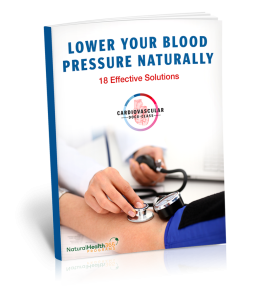
It dives deeper into food tweaks, stress busters, and sleep hacks that dovetail perfectly with your new micro-move routine.
Download it here —no spam, pinky swear.
The take-home message
Sitting itself isn’t the villain; unbroken sitting is. Your heart loves rhythm: beats, pulses, ups, downs. By sprinkling five easy moves into the cracks of your schedule, you restore that rhythm, keep arteries supple, and swap brain fog for steady energy.
No spandex. No memberships. Just you, your chair, and the decision to move for two minutes right now.
References
American Heart Association. (2021). Scientific statement: Sedentary behavior and cardiovascular risk. https://www.heart.org
Biswas, A., Oh, P. I., Faulkner, G. E., et al. (2015). Sedentary time and its association with risk for disease incidence, mortality, and hospitalization in adults. Annals of Internal Medicine, 162(2), 123-132. https://doi.org/10.7326/M14-1651
Carter, S. E., Gladwell, V. F., & Dempsey, P. C. (2015). Breaking up sedentary time: A strategy to reduce blood pressure? Medicine & Science in Sports & Exercise, 47(10), 2108-2116. https://doi.org/10.1249/MSS.0000000000000646
Dempsey, P. C., Larsen, R. N., Sethi, P., et al. (2016). Interrupting sitting reduces postprandial glucose and insulin responses. Diabetologia, 59, 823-834. https://doi.org/10.1007/s00125-015-3861-8
Diaz, K. M., Howard, V. J., Hutto, B., et al. (2017). Patterns of sedentary behavior in US middle-age and older adults. Annals of Internal Medicine, 167(7), 465-475. https://doi.org/10.7326/M16-2051
Ekelund, U., Steene-Johannessen, J., Brown, W. J., et al. (2016). Does physical activity attenuate, or even eliminate, the detrimental association of sitting time with mortality? The Lancet, 388(10051), 1302-1310. https://doi.org/10.1016/S0140-6736(16)30370-1
Padilla, J., Fadel, P. J., & Laughlin, M. H. (2018). Impact of acute exposure to prolonged sitting on arterial function. Medicine & Science in Sports & Exercise, 50(4), 862-869. https://doi.org/10.1249/MSS.0000000000001495
Park, S. H., & Han, K. S. (2018). Effect of chest expansion exercises on heart rate variability. Journal of Physical Therapy Science, 30(3), 369-372. https://doi.org/10.1589/jpts.30.369
Thosar, S. S., Bielko, S. L., Wiggins, C. C., & Jensen, M. D. (2015). A randomized crossover study on the acute effects of prolonged sitting and breaks in sitting on endothelial function. Medicine & Science in Sports & Exercise, 47(4), 843-849. https://doi.org/10.1249/MSS.0000000000000479
Wilmot, E. G., Edwardson, C. L., Achana, F. A., Davies, M. J., Gorely, T., Gray, L. J., … Biddle, S. J. H. (2012). Sedentary time in adults and the association with diabetes, cardiovascular disease and death: Systematic review and meta‐analysis. Diabetologia, 55(11), 2895–2905. https://doi.org/10.1007/s00125-012-2677-z
This article is for general education and isn’t personal medical advice. Chat with your healthcare provider before starting a new exercise routine, especially if you have cardiovascular or metabolic conditions.
